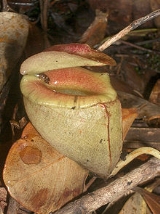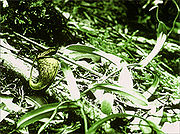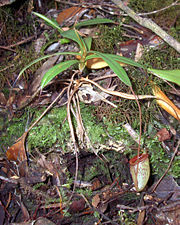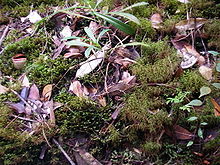
Nepenthes tenuis
Encyclopedia
Nepenthes tenuis is a tropical pitcher plant
endemic
to Sumatra
. The species was first collected in 1957, from a remote mountain in the western part of the island. It remained undescribed until 1994, and was only rediscovered in the wild in 2002. Prior to this, N. tenuis was known solely from a single photograph and dried herbarium specimen.
on August 24, 1957. It was discovered near Taram, West Sumatra
, in a sandstone region of the river Tjampo. The plants were growing on a ridge at approximately 1000 m above sea level, making N. tenuis an intermediate species. The habitat was described as "light sub-montane forest".
 Nepenthes tenuis was formally described
Nepenthes tenuis was formally described
as a species in 1994 by Joachim Nerz
and Andreas Wistuba
, based on a single specimen deposited by Meijer at the Leiden herbarium and a black and white photograph from 1957 showing the freshly collected plant. After several failed expeditions, the species was finally rediscovered in the wild in late 2002 by a team comprising Andreas Wistuba, Joachim Nerz, Michael Schach, and others.
Leaves are sessile and coriaceous. The lamina is lanceolate in morphology, 5–6 cm long, and 1-1.5 cm wide. It has an acute apex and is gradually attenuate towards the base, clasping the stem for two-thirds of its width (without a sheath). The lamina has indistinct nervation. Three or so longitudinal veins are present on either side of the midrib, originating from the basal third of the midrib and running parallel to it in the outer half of the lamina. Pinnate veins are oblique and irregularly reticulate, although they are not easily distinguishable. Tendrils are approximately 1.5 times as long as the lamina, growing to 12 cm in length and 0.5–1 mm in thickness. The tendrils may or may not curl around surrounding objects for support.
 Nepenthes tenuis is one of the smallest-pitchered species in the genus, possibly only second to N. argentii
Nepenthes tenuis is one of the smallest-pitchered species in the genus, possibly only second to N. argentii
. Upper pitchers gradually arise from the ends of the tendrils, forming a 10 mm wide curve. They are widely infundibuliform (funnel-shaped) throughout and contracted below the mouth. These aerial pitchers are usually 2.5-4.5 cm high and 1.5-2.5 cm wide. Both lower and upper pitchers lack wings or fringe elements. Instead, they bear two prominent ribs running down the front, 3–5 mm apart. The gland
ular region covers the entire inner surface of the pitchers. The glands are small and occur at a density of 600-800 per square centimetre. The pitcher mouth is ovate and almost horizontal. The flattened peristome
may be up to 6 mm wide, bearing ribs spaced 1/8 mm apart. The lid is narrow-elliptic, lacks appendages, and possesses two prominent veins, one on each side of the midrib. It is usually 1.5-2.5 cm long and 0.5-0.8 cm wide. Glands are evenly distributed on the underside of the lid. An unbranched, 1 mm long spur is inserted close to the base of the lid.
 Most parts of the plant are glabrous, although some may be covered with a sparse indumentum
Most parts of the plant are glabrous, although some may be covered with a sparse indumentum
of simple hairs. Herbarium specimens are dark brown in colour. On living plants, the pitchers are yellow-green and often have varying amounts of red-brown blotches. The peristome may be yellow to dark brown.
and Martin Cheek
reduced N. tenuis to a synonym
of N. dubia
"with some hesitation". Material representing the natural hybrid N. inermis
× N. talangensis
(N. × pyriformis) was also identified by the authors as belonging to N. dubia. However, this interpretation is not followed by Charles Clarke
, who does not consider the three taxa to be conspecific.
Nepenthes dubia and N. tenuis can be distinguished with relative ease. Most obviously, the pitchers of N. tenuis have shorter, broader lids that are never reflexed beyond 180°, unlike those of N. dubia, which are always reflexed beyond 180°. The pitchers of N. tenuis are also differently coloured, often having red flecks on the outside, in contrast to those of N. dubia, which are usually a solid yellow or orange colour. The peristome
of N. tenuis is also less tightly cylindrical than that of N. dubia.
Nepenthes tenuis can be distinguished from N. jacquelineae by its linear-lanceolate leaf blade (as opposed to ovate-spathulate in the latter) and lack of large gland
s on the lower surface of the lid. The lid of N. jacquelineae also differs by being noticeably contracted towards the base. Finally, N. jacquelineae is far larger in stature compared with N. tenuis and its pitchers have a far more developed and broader peristome that is almost horizontal.
In their description of the species, Nerz and Wistuba included a table of "characteristics which clearly distinguish Nepenthes tenuis from similar species":
Charles Clarke
writes that "the obvious similarities between N. tenuis, N. talangensis and N. jacquelineae are suggestive of recent adaptive radiation, and add further weight to the argument that the non-volcanic mountains of Bukit Barisan are the primary source of morphological diversity in Sumatran Nepenthes".
In 2001, Clarke performed a cladistic analysis of the Nepenthes species of Sumatra and Peninsular Malaysia
using 70 morphological characteristics of each taxon. The following is part of the resultant cladogram
, showing "Clade 1", which has 51% bootstrap support. Its most strongly supported subclade is the sister pair of N. inermis and N. dubia, having 95% support.
 Nepenthes tenuis grows in mossy forest and light sub-montane forest at the tops of sandstone
Nepenthes tenuis grows in mossy forest and light sub-montane forest at the tops of sandstone
ridges. The only known population occurs at an elevation of 1000–1200 m above sea level. N. tenuis is endemic
to a region of the Tjampo river east of Taram in West Sumatra
. Most ridges in this area have an elevation of just below 1000 m, although several exceed this height.
Terrestrial pitchers of N. tenuis often develop partially embedded in moss
. The lower parts of the stem may also be covered under a layer of moss, making the plants difficult to find in the wild.
In its natural habitat, the species is sympatric with N. adnata
and grows in close proximity to N. albomarginata
, N. ampullaria
, N. eustachya
, N. gracilis
, N. longifolia
, and N. reinwardtiana
. Despite this, no natural hybrids involving N. tenuis have been recorded.
Nepenthes tenuis is listed as Data Deficient
on the 2006 IUCN Red List of Threatened Species
. The habitat of this species may be threatened in the near future by fires deliberately started to clear forest for agricultural
purposes.
Pitcher plant
Pitcher plants are carnivorous plants whose prey-trapping mechanism features a deep cavity filled with liquid known as a pitfall trap. It has been widely assumed that the various sorts of pitfall trap evolved from rolled leaves, with selection pressure favouring more deeply cupped leaves over...
endemic
Endemic (ecology)
Endemism is the ecological state of being unique to a defined geographic location, such as an island, nation or other defined zone, or habitat type; organisms that are indigenous to a place are not endemic to it if they are also found elsewhere. For example, all species of lemur are endemic to the...
to Sumatra
Sumatra
Sumatra is an island in western Indonesia, westernmost of the Sunda Islands. It is the largest island entirely in Indonesia , and the sixth largest island in the world at 473,481 km2 with a population of 50,365,538...
. The species was first collected in 1957, from a remote mountain in the western part of the island. It remained undescribed until 1994, and was only rediscovered in the wild in 2002. Prior to this, N. tenuis was known solely from a single photograph and dried herbarium specimen.
Discovery and naming
Nepenthes tenuis was first collected by Willem MeijerWillem Meijer
Willem 'Wim' Meijer was a Dutch botanist and plant collector.-Background and education:Meijer was born in 1923 in The Hague, Netherlands. He received his Ph.D. from the University of Amsterdam in 1951...
on August 24, 1957. It was discovered near Taram, West Sumatra
West Sumatra
West Sumatra is a province of Indonesia. It lies on the west coast of the island Sumatra. It borders the provinces of North Sumatra to the north, Riau and Jambi to the east, and Bengkulu to the southeast. It includes the Mentawai Islands off the coast...
, in a sandstone region of the river Tjampo. The plants were growing on a ridge at approximately 1000 m above sea level, making N. tenuis an intermediate species. The habitat was described as "light sub-montane forest".

Species description
A species description or type description is a formal description of a newly discovered species, usually in the form of a scientific paper. Its purpose is to give a clear description of a new species of organism and explain how it differs from species which have been described previously, or are...
as a species in 1994 by Joachim Nerz
Joachim Nerz
Dr. Joachim Nerz is a taxonomist and botanist specialising in the carnivorous plant genera Heliamphora and Nepenthes. Nerz has described several new species, mostly with Andreas Wistuba.-Publications:...
and Andreas Wistuba
Andreas Wistuba
Dr. Andreas Wistuba is a German taxonomist and botanist specialising in the carnivorous plant genera Heliamphora and Nepenthes. More than half of all known Heliamphora species have been described by Wistuba.-Publications:...
, based on a single specimen deposited by Meijer at the Leiden herbarium and a black and white photograph from 1957 showing the freshly collected plant. After several failed expeditions, the species was finally rediscovered in the wild in late 2002 by a team comprising Andreas Wistuba, Joachim Nerz, Michael Schach, and others.
Description
Nepenthes tenuis is a climbing plant. The stem is slender (2–3 mm thick) and angular to rhomboid in cross section. Internodes are 5-6.5 cm long.Leaves are sessile and coriaceous. The lamina is lanceolate in morphology, 5–6 cm long, and 1-1.5 cm wide. It has an acute apex and is gradually attenuate towards the base, clasping the stem for two-thirds of its width (without a sheath). The lamina has indistinct nervation. Three or so longitudinal veins are present on either side of the midrib, originating from the basal third of the midrib and running parallel to it in the outer half of the lamina. Pinnate veins are oblique and irregularly reticulate, although they are not easily distinguishable. Tendrils are approximately 1.5 times as long as the lamina, growing to 12 cm in length and 0.5–1 mm in thickness. The tendrils may or may not curl around surrounding objects for support.

Nepenthes argentii
Nepenthes argentii is a highland Nepenthes pitcher plant native to Mount Guiting-Guiting on Sibuyan Island in the Philippines. It is possibly the smallest species in the genus and does not appear to have a climbing stage....
. Upper pitchers gradually arise from the ends of the tendrils, forming a 10 mm wide curve. They are widely infundibuliform (funnel-shaped) throughout and contracted below the mouth. These aerial pitchers are usually 2.5-4.5 cm high and 1.5-2.5 cm wide. Both lower and upper pitchers lack wings or fringe elements. Instead, they bear two prominent ribs running down the front, 3–5 mm apart. The gland
Gland
A gland is an organ in an animal's body that synthesizes a substance for release of substances such as hormones or breast milk, often into the bloodstream or into cavities inside the body or its outer surface .- Types :...
ular region covers the entire inner surface of the pitchers. The glands are small and occur at a density of 600-800 per square centimetre. The pitcher mouth is ovate and almost horizontal. The flattened peristome
Peristome
The word peristome is derived from the Greek peri, meaning 'around' or 'about', and stoma, 'mouth'. It is a term used to describe various anatomical features that surround an opening to an organ or structure. The term is used in plants and invertebrate animals, such as in describing the shells of...
may be up to 6 mm wide, bearing ribs spaced 1/8 mm apart. The lid is narrow-elliptic, lacks appendages, and possesses two prominent veins, one on each side of the midrib. It is usually 1.5-2.5 cm long and 0.5-0.8 cm wide. Glands are evenly distributed on the underside of the lid. An unbranched, 1 mm long spur is inserted close to the base of the lid.

Indumentum
The indumentum is a covering of fine hairs or bristles on a plant or insect.In plants, the indumentum types are:*pubescent*hirsute*pilose*villous*tomentose*stellate*scabrous*scurfy...
of simple hairs. Herbarium specimens are dark brown in colour. On living plants, the pitchers are yellow-green and often have varying amounts of red-brown blotches. The peristome may be yellow to dark brown.
Taxonomy
In their 1997 monograph, Matthew JebbMatthew Jebb
Dr. Matthew H. P. Jebb is an Irish taxonomist and botanist specialising in the ant plant genera Squamellaria, Myrmecodia, Hydnophytum, Myrmephytum and Anthorrhiza, as well as the carnivorous plant genus Nepenthes....
and Martin Cheek
Martin Cheek
Dr. Martin Roy Cheek is a taxonomist and botanist specialising in the carnivorous plant genus Nepenthes.-Research:Cheek has described several new Nepenthes species, mostly with Matthew Jebb, including: N. argentii, N. aristolochioides, N. danseri, N. diatas,...
reduced N. tenuis to a synonym
Synonym
Synonyms are different words with almost identical or similar meanings. Words that are synonyms are said to be synonymous, and the state of being a synonym is called synonymy. The word comes from Ancient Greek syn and onoma . The words car and automobile are synonyms...
of N. dubia
Nepenthes dubia
Nepenthes dubia is a tropical pitcher plant endemic to Sumatra. The specific epithet dubia is the Latin word for "doubtful".-Botanical history:...
"with some hesitation". Material representing the natural hybrid N. inermis
Nepenthes inermis
Nepenthes inermis is a tropical pitcher plant endemic to Sumatra. The specific epithet inermis is Latin for "unarmed" and probably refers to the upper pitchers of this species, which are unique in that they completely lack a peristome....
× N. talangensis
Nepenthes talangensis
Nepenthes talangensis is a tropical pitcher plant endemic to Sumatra, where it grows in upper montane forest at elevations of 1800–2500 m above sea level....
(N. × pyriformis) was also identified by the authors as belonging to N. dubia. However, this interpretation is not followed by Charles Clarke
Charles Clarke (botanist)
Dr. Charles M. Clarke is a botanist and taxonomist specialising in the carnivorous plant genus Nepenthes. Clarke has an honours degree in Botany from Monash University in Melbourne, and a Ph.D. in Ecosystem Management at the University of New England, in Armidale, New South Wales.Clarke first...
, who does not consider the three taxa to be conspecific.
Nepenthes dubia and N. tenuis can be distinguished with relative ease. Most obviously, the pitchers of N. tenuis have shorter, broader lids that are never reflexed beyond 180°, unlike those of N. dubia, which are always reflexed beyond 180°. The pitchers of N. tenuis are also differently coloured, often having red flecks on the outside, in contrast to those of N. dubia, which are usually a solid yellow or orange colour. The peristome
Peristome
The word peristome is derived from the Greek peri, meaning 'around' or 'about', and stoma, 'mouth'. It is a term used to describe various anatomical features that surround an opening to an organ or structure. The term is used in plants and invertebrate animals, such as in describing the shells of...
of N. tenuis is also less tightly cylindrical than that of N. dubia.
Nepenthes tenuis can be distinguished from N. jacquelineae by its linear-lanceolate leaf blade (as opposed to ovate-spathulate in the latter) and lack of large gland
Gland
A gland is an organ in an animal's body that synthesizes a substance for release of substances such as hormones or breast milk, often into the bloodstream or into cavities inside the body or its outer surface .- Types :...
s on the lower surface of the lid. The lid of N. jacquelineae also differs by being noticeably contracted towards the base. Finally, N. jacquelineae is far larger in stature compared with N. tenuis and its pitchers have a far more developed and broader peristome that is almost horizontal.
In their description of the species, Nerz and Wistuba included a table of "characteristics which clearly distinguish Nepenthes tenuis from similar species":
Character N. bongso N. dubia N. talangensis N. tenuis Shape of upper pitchers tubulate - infundibulate tubulous in the lower part, infundibulate above the middle tubulous to narrow infundibuliform in the lower half, ovate in the upper half wide infundibulate, contracted below the mouth Lid orbiculate narrow cuneate broad-ovate very narrow elliptical Length/width ratio of upper pitchers 3.3 1.9 2.3 1.75
Charles Clarke
Charles Clarke (botanist)
Dr. Charles M. Clarke is a botanist and taxonomist specialising in the carnivorous plant genus Nepenthes. Clarke has an honours degree in Botany from Monash University in Melbourne, and a Ph.D. in Ecosystem Management at the University of New England, in Armidale, New South Wales.Clarke first...
writes that "the obvious similarities between N. tenuis, N. talangensis and N. jacquelineae are suggestive of recent adaptive radiation, and add further weight to the argument that the non-volcanic mountains of Bukit Barisan are the primary source of morphological diversity in Sumatran Nepenthes".
In 2001, Clarke performed a cladistic analysis of the Nepenthes species of Sumatra and Peninsular Malaysia
Peninsular Malaysia
Peninsular Malaysia , also known as West Malaysia , is the part of Malaysia which lies on the Malay Peninsula. Its area is . It shares a land border with Thailand in the north. To the south is the island of Singapore. Across the Strait of Malacca to the west lies the island of Sumatra...
using 70 morphological characteristics of each taxon. The following is part of the resultant cladogram
Cladogram
A cladogram is a diagram used in cladistics which shows ancestral relations between organisms, to represent the evolutionary tree of life. Although traditionally such cladograms were generated largely on the basis of morphological characters, DNA and RNA sequencing data and computational...
, showing "Clade 1", which has 51% bootstrap support. Its most strongly supported subclade is the sister pair of N. inermis and N. dubia, having 95% support.
Natural habitat and distribution

Sandstone
Sandstone is a sedimentary rock composed mainly of sand-sized minerals or rock grains.Most sandstone is composed of quartz and/or feldspar because these are the most common minerals in the Earth's crust. Like sand, sandstone may be any colour, but the most common colours are tan, brown, yellow,...
ridges. The only known population occurs at an elevation of 1000–1200 m above sea level. N. tenuis is endemic
Endemic (ecology)
Endemism is the ecological state of being unique to a defined geographic location, such as an island, nation or other defined zone, or habitat type; organisms that are indigenous to a place are not endemic to it if they are also found elsewhere. For example, all species of lemur are endemic to the...
to a region of the Tjampo river east of Taram in West Sumatra
West Sumatra
West Sumatra is a province of Indonesia. It lies on the west coast of the island Sumatra. It borders the provinces of North Sumatra to the north, Riau and Jambi to the east, and Bengkulu to the southeast. It includes the Mentawai Islands off the coast...
. Most ridges in this area have an elevation of just below 1000 m, although several exceed this height.
Terrestrial pitchers of N. tenuis often develop partially embedded in moss
Moss
Mosses are small, soft plants that are typically 1–10 cm tall, though some species are much larger. They commonly grow close together in clumps or mats in damp or shady locations. They do not have flowers or seeds, and their simple leaves cover the thin wiry stems...
. The lower parts of the stem may also be covered under a layer of moss, making the plants difficult to find in the wild.
In its natural habitat, the species is sympatric with N. adnata
Nepenthes adnata
Nepenthes adnata is a tropical pitcher plant endemic to the Indonesian province of West Sumatra, where it grows at elevations of 600 to 1200 m above sea level. The specific epithet adnata is Latin for "broadly attached" and refers to the base of the lamina.-Botanical history:Nepenthes adnata was...
and grows in close proximity to N. albomarginata
Nepenthes albomarginata
Nepenthes albomarginata , the White-Collared Pitcher-Plant, is a tropical pitcher plant native to Borneo, Peninsular Malaysia, and Sumatra...
, N. ampullaria
Nepenthes ampullaria
Nepenthes ampullaria , the Flask-Shaped Pitcher-Plant, is a very distinctive and widespread species of Nepenthes, present in Borneo, Sumatra, Thailand, Peninsular Malaysia, Singapore, the Maluku Islands, and New Guinea...
, N. eustachya
Nepenthes eustachya
Nepenthes eustachya is a tropical pitcher plant endemic to Sumatra, where it grows from sea level to an elevation of 1600 m. The specific epithet eustachya, formed from the Greek words eu and stachys , refers to the racemose structure of the inflorescence.-Botanical history:Nepenthes eustachya...
, N. gracilis
Nepenthes gracilis
Nepenthes gracilis , or the Slender Pitcher-Plant, is a very common lowland pitcher plant that is widespread in the Sunda region. It has been recorded from Borneo, Peninsular Malaysia, Singapore, central Sulawesi, Sumatra, and southernmost Thailand...
, N. longifolia
Nepenthes longifolia
Nepenthes longifolia is a tropical pitcher plant endemic to Sumatra, where it grows at elevations of between 300 and 1100 m above sea level. The specific epithet longifolia, formed from the Latin words longus and folius , refers to the exceptionally large leaves of this species.-Botanical...
, and N. reinwardtiana
Nepenthes reinwardtiana
Nepenthes reinwardtiana , Reinwardt's Pitcher-Plant, is a Nepenthes species found on the islands of Borneo and Sumatra. Although some sources have included Peninsular Malaysia and Singapore within the range of this species, these records appear to be erroneous.Nepenthes reinwardtiana has an...
. Despite this, no natural hybrids involving N. tenuis have been recorded.
Nepenthes tenuis is listed as Data Deficient
Data Deficient
Data Deficient is a category applied by the IUCN, other agencies, and individuals to a species when the available information is not sufficient for a proper assessment of conservation status to be made...
on the 2006 IUCN Red List of Threatened Species
IUCN Red List
The IUCN Red List of Threatened Species , founded in 1963, is the world's most comprehensive inventory of the global conservation status of biological species. The International Union for Conservation of Nature is the world's main authority on the conservation status of species...
. The habitat of this species may be threatened in the near future by fires deliberately started to clear forest for agricultural
Agriculture
Agriculture is the cultivation of animals, plants, fungi and other life forms for food, fiber, and other products used to sustain life. Agriculture was the key implement in the rise of sedentary human civilization, whereby farming of domesticated species created food surpluses that nurtured the...
purposes.

